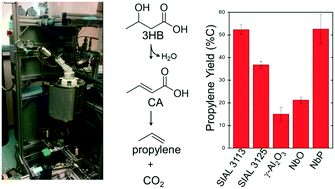Vapor-phase conversion of aqueous 3-hydroxybutyric acid and crotonic acid to propylene over solid acid catalysts†
Abstract
Diverse sources of wastewater organic carbon can be microbially funneled into biopolymers like polyhydroxybutyrate (PHB) that can be further valorized by conversion to hydrocarbon fuels and industrial chemicals. We report the vapor-phase dehydration and decarboxylation of PHB-derived monomer acids, 3-hydroxybutyric acid (3HB) and crotonic acid (CA), in water to propylene over solid acid catalysts using a packed-bed continuous-flow reactor. Propylene yields increase with increased Brønsted acidity of catalysts, with amorphous silica–alumina and niobium phosphate yielding 52 and 60 %C (percent feedstock carbon, max 75 %C) of feedstock 3HB and CA, respectively; additional products include CO2 and retro-aldol products (acetaldehyde and acetic acid). Deactivation studies indicate progressive and permanent steam deactivation of amorphous silica–alumina, while re-calcination partially recovers niobium phosphate activity. Experiments demonstrating sustained reactor operation over niobium phosphate provide a promising technology pathway for increasing valorization of organic-rich wastewater.



 Please wait while we load your content...
Please wait while we load your content...